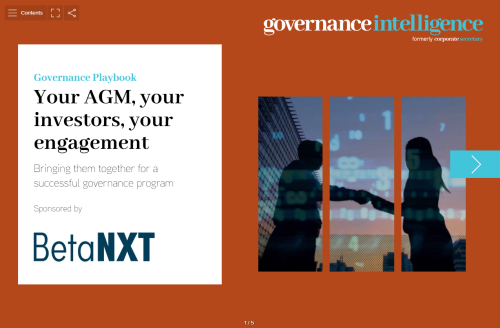The growth in passive investing is driving collaboration between activist investors and index managers on initiatives intended to seek long-term value creation, according to industry experts.
Earlier this year, for example, activist fund firm Jana Partners and CalSTRS co-signed a petition to Apple on social issues, and several activist managers – including Jana Partners and ValueAct Capital – co-signed the Investor Stewardship Framework that was also backed by more than 40 passive funds. The initiative launched in the US on January 1.
This collaboration is partly symptomatic of indexed funds looking to ESG issues as an indicator of long-term value creation, according to Jennifer Almquist, founder of Ivy Street Advisory. Speaking on a recent NIRI webinar, she said activists know that as index funds get larger, they can provide more clout for campaigns against management during a proxy contest.
She added: ‘If you’re a passive asset manager and you don’t like a stock, you can’t sell it. If you want to influence a company, how do you do it? That’s where ESG comes in. Good governance lowers perceived risks, which in turn lowers the long-term cost of capital… We’ve already heard a lot of index managers saying they’re going to engage on ESG issues.
‘We also know a lot of really large active managers are on the same page. If an active manager wanted to lead a campaign before, it would have to approach the top 10 investors to go with it. But now, with the size of index funds, it may only need to approach one or two.’
Both Almquist and fellow panelist JT Farley, managing director of investor relations and corporate communications at Investment Technology Group, emphasized the importance of IR professionals understanding their company’s stance on the ESG issues that are pertinent to their investors. Almquist called for greater collaboration between IR, legal and sustainability teams to ensure cohesive communication with investors.
Farley explained that this is squarely within the mandate of the IR department, given that it will affect which indices a stock is included in. ‘You really need to pay attention to which exchange-traded funds (ETFs) you’re in, which indices you’re in and which smart beta ETFs you’re in,’ he said. ‘You need to know how your corporate governance and capital allocation and going to impact your inclusion in these indexes. They can’t buy and sell but if they gain $1 bn, you’re going to see huge surges.’
Importance of engagement
The asset flows into passive funds are likely to continue to grow, according to Phillip Brzenk, director of global research and design at S&P Dow Jones Indices. The SPIVA Scorecard, an S&P Dow Jones research report that compares the performance of actively managed funds relative to their appropriate benchmarks, shows particularly high performance of indexed funds in the US and Canada, among the mature markets.
| Country | Benchmark | One year | Three year | Five year |
| US | S&P 500 | 63% | 81% | 84% |
| Canada | S&P / TSX composite | 93% | 91% | 82% |
| Europe | S&P Europe 350 | 47% | 59% | 73% |
| Japan | S&P Topix 150 | 15% | 34% | 44% |
| India | S&P BSE 100 | 59% | 53% | 43% |
Source: S&P Dow Jones SPIVA Scorecard
Almquist and Farley underscored the importance of engagement with passive investors on ESG issues. ‘You need to engage and do off-cycle outreach,’ Farley said. ‘Governance outreach should and must include passive managers. You should be reaching out once a year, if not more – but don’t do it during proxy season. The fall is a good time to do these things.’
Farley added that his company discloses in its proxy statement how much of its investor base it has contacted and met with. Last year he met with 30 percent of his investor base but contacted 70 percent. He said transparency demonstrates his commitment to a dialogue around ESG issues.
Almquist added that IR teams should consider integrating ESG talking points into their non-deal roadshow talking points.









